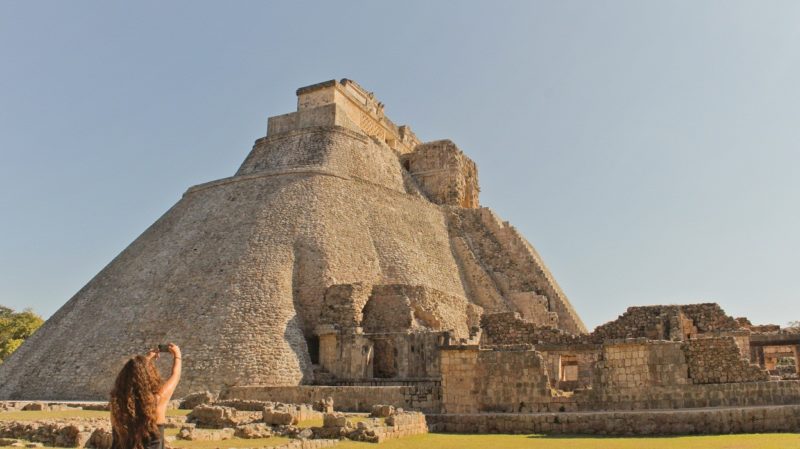Ruta Puuc on your trip to Merida or Mexico
The Puuc Route, or Ruta Puuc, is a collection of Mayan ruins sites about halfway between the cities of Merida and Campeche in the Yucatan Peninsula. On this route are Mayan sites, the caves of Loltún, cenotes, and Mayan villages and cities. The route is named for the Puuc hills in which it is located, and also for the architectural style of the area. The sites include Uxmal, Kabah, Sayil, X-Lapak and Labna.
The easiest method of exploring the Ruta Puuc is to take one of the many tours out of Merida, Campeche or even Cancun. It is also possible to rent a car and use a map to find your way around or take a public bus tour out of Merida. The route can start either at the caves or at Uxmal, and you then travel down the route to see the five sites in succession. It is possible to do this as a day trip providing you start early, make good time, and don’t stay more than an hour at each location. There are numerous hotels in the area for those who which to stay longer.
Uxmal
Uxmal, a World Heritage Site, is the prime example of Puuc architecture and the home of many monumental and beautiful structures. (Please see the section on Uxmal elsewhere in this website.) It is the largest and most impressive of the sites on the Ruta Puuc. It has a tourist center with shops, restaurants and rest rooms. Open 365 days a year from 8 a.m. to 5 p.m. with a $10 entrance fee. Evening light and sound show.
Kabah
Kabah, to the south of Uxmal, is the second largest ruin of the Puuc region, and a Yucatán state park. It is connected to Uxmal by a 18 km long sacbe, a raised pedestrian causeway 5 meters wide with monumental arches at each end. Kabah is famous for its ornate Temple to Chaac, the Rain God of the Maya, whose facade is covered with repetitious masks of Chaac. The site also has a number of other palaces, low stone buildings, and step-pyramid temples.
The area was populated by the mid 3rd century BC, but most of the architecture was built between the 7th century and the 11th century. Kabah was abandoned for several centuries before the Spanish arrived in America.
Sayil
Further south of Kabah is the park of Sayil, which was home to between 5,000 and 10,000 people beginning about 800 AD. It reached its peak population and a size of three and a half square kilometers a hundred years later, but was abandoned about 1000 AD. It was rediscovered and brought to the world’s attention in the 1800s.
The site is laid out along a sacbe, or causeway, running from north to south. The Great Palace stands at the northern end of the causeway and is the largest and most well known building at Sayil with an 85-meter-long facade built upon a two-terraced platform. The palace contains 90 bedrooms for some 350 people. Further down this causeway is another complex of structures including El Mirador., a temple pyramid. Other major groups containing a ball court and several palaces are spread out along this causeway system.
X-Lapak
Continuing down the Ruta Puuc you will come to X-Lapak, a small site located between Sayil and Labná. It is a site of some 14 mounds, a nine room palace with decorated facades, and three somewhat restored pyramids. This site is less developed and more like the ruins as they were before rediscovery, but still well-preserved. The buildings are typical of this Puuc style with highly decorated upper portions of the buildings that extend above the ceiling height. Entrance is free.
Labna
Labna was incorporated with Uxmal as a UNESCO World Heritage Site in 1996. The comparatively small site was once home to about 2,000 people, and now has four restored buildings. These include a large two-story palace which is about 400 feet long, and an elaborately decorated gateway arch. The well-known and well-photographed arch is about 40 feet wide and 20 feet high, and its bas relief carvings are typical of the highly ornamented Puuc style. Next to this gateway stands “El Mirador”, a pyramid-like structure surmounted by a temple. Also on the site is the Temple of the Columns. The site was built in the Late and Terminal Classic era. A date corresponding to AD 862 is inscribed in the palace. The site is open to visitors for a small entrance fee.
Loltún Caves
To end the trip continue to the Loltún Caves. Or, you can begin your trip here and continue in reverse order of this list. Access to the caves is by tour only, and they start at 9:30 am, 11:00 am, 12:00 noon, 2:00 pm, 3:00 pm and 4:00 pm. There is a small entrance fee.







Leave A Comment